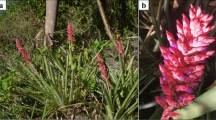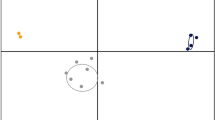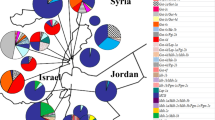Abstract
Plant species of various families, such as those of Bromeliaceae, occur on inselbergs where they are subject to geographic isolation and environmental conditions that can lead to genetic erosion. This, in turn, can result in the loss of natural populations due to homozygosis, or changes in ploidy that may lead to reproductive isolation. The genetic diversity of five natural populations of Pitcairnia azouryi was measured using nine microsatellite markers transferred from P. albiflos and P. geyskesii. Chromosome numbers and nuclear DNA content were also evaluated. The results indicated moderate genetic differentiation among populations (FST = 0.188), and significant gene flow (Nm = 1.073) in four of the five populations. P. azouryi has, predominantly, 2n = 50 chromosomes and DNA content of 2C = 1.16 pg, but the tetraploid condition was found (2n = 100 and 2C = 2.32 pg) in seedlings of an individual of the most geographically isolated population. The moderate level of genetic structuring observed for P. azouryi seems to be related to its disjoint geographical distribution and the locally aggregated spatial structure of the populations, which are isolated from each other, hindering the inter and intrapopulational gene flow. This interpretation was also evidenced by the mantel test (r = 0.777, P < 0.05). The occurrence of diploid individuals with tetraploid seedlings is indicative of events of eupolyploidization, possibly due to the environmental conditions of this geographically isolated population.





Similar content being viewed by others
References
Bornhardt W (1900) Zur Oberflächen-Gestaltung und Geologie Deutsch-Ostafrikas. « Deutsch Ostafrika » ., vol 7. Dietrich Reimer, Berlin
Guerra AT (2001) Novo dicionário Geológico—Geomorfológico, 2nd edn. Bertrand Brasil, Rio de Janeiro
Barbará T, Martinelli G, Palma-Silva C, Fay MF, Mayo S, Lexer C (2009) Genetic relationships and variation in reproductive strategies in four closely related bromeliads adapted to neotropical ‘inselbergs’: Alcantarea glaziouana, A. regina, A. geniculata and A. imperialis (Bromeliaceae). Ann Bot 103:65–77
Flora do Brasil 2020 em construção. Jardim Botânico do Rio de Janeiro. Disponível em: <http://floradobrasil.jbrj.gov.br/>
De Paula LFA, Forzza RC, Neri AV, Bueno ML, Porembski S (2016) Sugar Loaf Land in south-eastern Brazil: a centre of diversity for mat-forming bromeliads on inselbergs. Bot J Linn Soc 181:459–476
Colley E, Fischer ML (2013) Especiação e seus mecanismos: histórico conceitual e avanços recentes. História, Ciências, Saúde—Manguinhos 20(4):1671–1694
Coyne JA, Orr HÁ (2004) Speciation. Sinauer Associates, Sunderland
Savolainen V, Anstett MC, Lexer C, Hutton I, Clarkson JJ, Norup MV, Powell MP, Springate D, Salamin N, Baker WJ (2006) Sympatric speciation in palms on an oceanic island. Nature 44:210–213
Ellstrand NC, Elam DR (1993) Population genetic consequences of small population size: implications for plant conservation. Annu Rev Ecol Syst 24:217–242
Reed DH, Frankham R (2003) Correlation between fitness and genetic diversity. Conserv Biol 17(1):230–237
Johansson M, Primmer CR, Merila J (2007) Does habitat fragmentation reduce fitness and adaptability? A case study of the common frog (Rana temporaria). Mol Ecol 16:2693–2700
Barbará T, Martinelli G, Fay MF, Mayo SJ, Lexer C (2007) Population differentiation and species cohesion in two closely related plants adapted to neotropical high-altitude ‘inselbergs’, Alcantarea imperialis and Alcantarea geniculata (Bromeliaceae). Mol Ecol 16:1981–1992
Palma-Silva C, Wendt T, Pinheiro F, Barbará T, Fay MF, Cozzolino S, Lexer C (2011) Sympatric bromeliad species (Pitcairnia spp.) facilitate tests of mechanisms involved in species cohesion and reproductive isolation in Neotropical inselbergs. Mol Ecol 20:3185–3201
Hmeljevski KV, Freitas L, Domingues R, Pereira AR, Cancio AS, Andrade ACS, Machado MA, Viccini LF, Forzza RC (2014) Conservation assessment of an extremely restricted bromeliad highlights the need for population-based conservation on granitic inselbergs of the Brazilian Atlantic Forest. Flora 209:250–259
Hmeljevski KV, Dos Reis MS, Forzza RC (2015) Patterns of gene flow in Encholirium horridum L.B.Sm., a monocarpic species of Bromeliaceae from Brazil. J Hered 106:93–101
Gonçalves-Oliveira RC, Wöhrmann T, Benko-Iseppon AM, Krapp F, Alves M, Wanderley MGL, Weising K (2017) Population genetic structure of the rock outcrop species Encholirium spectabile (Bromeliaceae): the role of pollination vs. seed dispersal and evolutionary implications. Am J Bot 104(6):868–878
Hmeljevski KV, Nazareno AG, Bueno ML, Reis MS, Forzza RC (2017) Do plant populations on distinct inselbergs talk to each other? A case study of genetic connectivity of a bromeliad species in an Ocbil landscape. Ecol Evol 7(13):4704–4716
Krejčíková J, Sudová R, Lučanová M, Trávníček P, Urfus T, Vít P, Weiss-Schneeweiss H, Kolano B, Oberlander K, Dreyer LL, Suda J (2013) High ploidy diversity and distinct patterns of cytotype distribution in a widespread species of Oxalis in the Greater Cape Floristic Region. Ann Bot 111:641–649
Otto SP, Whitton J (2000) Polyploid incidence and evolution. Annu Rev Genet 34:401–437
Levin DA (2002) The role of chromosomal change in plant evolution. Oxford University Press, Oxford, p 240
Leitch AR, Leitch IJ (2008) Genomic plasticity and the diversity of polyploid plants. Science 320(5875):481–483
Benko-Iseppon AM, Wanderley MGL (2002) Cytogenetic studies on Brazilian Xyris species (Xyridaceae). Bot J Linn Soc 138:245–252
Souza MGC, Benko-Iseppon AM (2004) Cytogenetics and chromosome banding patterns in Caesalpinioideae and Papilionoideae species of Pará, Amazonas, Brazil. Bot J Linn Soc 144:181–191
Salles-de-Melo MRC, Lucena RM, Semir J, Carvalho R, Pereira RCA, Benko-Iseppon AM (2010) Karyological features and cytotaxonomy of the tribe Vernonieae (Asteraceae). Plant Syst Evol 285:189–199
Barow M, Meister A (2003) Endopolyploidy in seed plants is differently correlated to systematics, organ, life strategy and genome size. Plant, Cell Environ 26:571–584
Paule J, Wagner ND, Weising K, Zizka G (2017) Ecological range shift in the polyploid members of the South American genus Fosterella (Bromeliaceae). Ann Bot 120:233–243
Gitai J, Paule J, Zizka G, Schulte K, Benko-Iseppon AM (2014) Chromosome numbers and DNA content in Bromeliaceae: additional data and critical review. Bot J Linn Soc 176:349–368
Martinelli G, Forzza RC (2006) Pitcairnia L´Hér. (Bromeliaceae): uma nova espécie, P. azouryi Martinelli and Forzza, e observações sobre P. encholirioides L.B. Sm. Rev Bras Bot 29(4):603–607
Leme EMC, Fontana AP, Halbritter H (2010) Three new Pitcairnia species (Bromeliaceae) from the inselbergs of Espírito Santo. Braz Syst Bot 35(3):487–496
Manhães VC, Couto DR, Miranda FD, Carrijo TT (2016) New findings on the distribution of Pitcairnia azouryi (Bromeliaceae), a species restricted to Atlantic Forest inselbergs. Phytotaxa 245(1):059–065
De Paula LFA, Mota NFO, Viana PL, Stehmann JR (2017) Floristic and ecological characterization of habitat types on an inselberg in Minas Gerais, southeastern Brazil. Acta Bot Bras 31(2):199–211
Petit RJ, Excoffier L (2009) Gene flow and species delimitation. Trends Ecol Evol 24:386–393
Doyle JJ, Doyle JL (1990) Isolation of plant DNA from fresh tissue. Focus 12:13–15
Paggi GM, Palma-Silva C, Bered F, Cidade FW, Sousa ACB, Souza AP, Wendt T, Lexer C (2008) Isolation and characterization of microsatellite loci in Pitcairnia albiflos (Bromeliaceae), an endemic bromeliad from the Atlantic Rainforest, and cross-amplification in other species. Mol Ecol Resour 8:980–982
Sarthou C, Boisselier-Dubayle MC, Lambourdiere J, Samadi S (2003) Polymorphic microsatellites for the study of fragmented populations. Mol Ecol Notes 3(2):221–223
Thiers B (2018) Index Herbariorum: A global directory of public herbaria and associated staff. New York Botanical Garden’s Virtual Herbarium. http://sweetgum.nybg.org/science/ih/. Accessed 20 Jan 2018
Cruz CD (2008) Programa Genes: diversidade genética. Universidade Federal de Viçosa, Viçosa
Yeh FC, Yang RC, Boyle BJ, Ye ZH, Mao JX (1997) POPGENE, the user-friendly shareware for population genetic analysis. Molecular Biology and Biotechnology Centre, University of Alberta, Edmonton
Goudet J (1995) FSTAT (version 1.2): a computer program to calculate F-statistics. J Hered 86:485–486
Weir B, Cockerham C (1984) Estimating F-statistics for the analysis of population structure. Evolution 38(6):1358–1370
Nei M, Chesser RK (1983) Estimation of fixation indexes and gene diversities. Ann Hum Genet 47:253–259
Van Oosterhout C, Hutchinson WF, Wills DPM, Shipley P (2004) Micro-checker: software for identifying and correcting genotyping errors in microsatellite data. Mol Ecol Notes 4:535–538
Wright S (1965) The interpretation of population structure by F-statistics with special regard to systems of mating. Evolution 19:395–420
Pritchard JK, Stephens M, Donnelly P (2000) Inference of population structure using multilocus genotype data. Genetics 155:945–959
Evanno G, Regnaut S, Goudet J (2005) Detecting the number of clusters of individuals using the software STRUCTURE: a simulation study. Mol Ecol 14:2611–2620
Earl DA, Von Holdt BM (2012) STRUCTURE HARVESTER: a website and program for visualizing STRUCTURE output and implementing the Evanno method. Conserv Genet Resour 4:359–361
Excoffier L, Laval G, Schneider S (2007) Arlequin ver. 3.0: an integrated software package for population genetics data analysis. Evolut Bioinform 1:47–50
Carvalho CR, Clarindo WR, Almeida PM (2007) Plant cytogenetics: still looking for the perfect mitotic chromosomes. Nucleus 50:453–462
Clarindo WR, Carvalho CR (2008) First Coffea arabica karyogram showing that this species is a true allotetraploid. Plant Syst Evol 274:237–241. https://doi.org/10.1007/s00606-008-0050-y
Praça-Fontes MM, Carvalho CR, Clarindo WR, Cruz CD (2011) Revisiting the DNA C-values of the genome size-standards used in plant flow cytometry to choose the “best primary standards”. Plant Cell Rep 30:1183–1191. https://doi.org/10.1007/s00299-011-1026-x
Otto FJ (1990) DAPI staining of fixed cells for high-resolution flow cytometry of nuclear DNA. In: Darzynkiewiez Z, Crissman HA, Robinson JP (eds) Methods in cell biology, vol 33. Academic Press, San Diego, pp 105–110
Nunes ACP, Nogueira EU, Gontijo ABPL, Carvalho CR, Clarindo WR (2013) The first karyogram of a Bromeliaceae species: an allopolyploid genome. Plant Syst Evol 299:1135–1140
Doležel J, Bartoš J, Voglmayr H, Greilhuber J (2003) Nuclear DNA and genome size of trout and human. Cytometry 51:127–128
Barbará T, Palma-Silva C, Paggi GM, Bered F, Fay MF, Lexer C (2007) Cross-species transfer of nuclear microsatellite markers: potential and limitations. Mol Ecol 16:3759–3767
Palma-Silva C, Cavallari M, Barbará T, Lexer C, Gimenes MA, Bered F, Bodanese-Zanettini MH (2007) A set polymorphic microsatellite loci for Vriesea gigantea and Alcantarea imperialis (Bromeliaceae) and cross-amplification in other bromeliad species. Mol Ecol Notes 7:654–657
Wang X, Rinehart TA, Wadl PA, Spiers JM, Hadziabdic D, Windham MT, Trigiano RN (2009) A new electrophoresis technique to separate microsatellite alleles. Afr J Biotechnol 8(11):2432–2436
Miranda FD, Gontijo ABPL, Santiliano FC, Favoreto FC, Soares TCB (2012) Transferability and characterization of microsatellite markers in five Bromeliaceae species belonging to the subfamilies Pitcairnioideae and Bromelioideae. Biota Neotrop 12(3):321–322
Palma-Silva C, Lexer C, Paggi GM, Barbara T, Bered F, Bodanese-Zanettini MH (2009) Range-wide patterns of nuclear and chloroplast DNA diversity in Vriesea gigantea (Bromeliaceae), a neotropical forest species. Heredity 103:503–512
Zanella CM, Bruxel M, Paggi GM, Goetze M, Buttow MV, Cidade FW, Bered F (2011) Genetic structure and phenotypic variation in wild populations of the medicinal tetraploid species Bromelia antiacantha (Bromeliaceae). Am J Bot 98:1511–1519
Goetze M, Büttow MV, Zanella CM, Paggi GM, Bruxel M, Pinheiro FG, Sampaio JAT, Palma-Silva C, Cidade FW, Bered F (2015) Genetic variation in Aechmea winkleri, a bromeliad from in land Atlantic rainforest fragment in Southern Brazil. Biochem Syst Ecol 58:204–210
Goetze M, Palma-Silva C, Zanella CM, Bered F (2016) East-to-west genetic structure in populations of Aechmea calyculata (Bromeliaceae) from the southern Atlantic rainforest of Brazil. Bot J Linn Soc 181(3):477–490
Honnay O, Jacquemyn H (2006) Susceptibility of common and rare plant species to the genetic consequences of habitat fragmentation. Conserv Biol 21(3):823–831
Boisselier-Dubayle MC, Leblois R, Samadi S, Lambourdière J, Sarthou C (2010) Genetic structure of the xerophilous bromeliad Pitcairnia geyskesii on inselbergs in French Guiana a test of the forest refuge hypothesis. Ecography 33:175–184
Lavor P, Van Den Berg C, Jacobi CM, Carmo FF, Versieux LM (2014) Population genetics of the endemic and endangered Vriesea minarum (Bromeliaceae) in the iron quadrangle, Espinhaço Range. Braz Am J Bot 101(7):1–9
Tero N, Aspi J, Siikamäki P, Jäkäläniemi A, Tuomi J (2003) Genetic structure and gene flow in a metapopulation of an endangered plant species, Silene tatarica. Mol Ecol 12:2073–2085
Whitlock MC (1992) Temporal fluctuations in demographic parameters and the genetic variance among populations. Evolution 46(3):608–615
Templeton AR (1980) Modes of speciation and inferences based on genetic distances. Evolution 34(4):719–729
Hedrick PW (2007) A standardized genetic differentiation measure. Evolution 59(8):1633–1638
Gitaí J, Horres R, Benko-Iseppon AM (2005) Chromosome features and evolution of Bromeliaceae. Plant Syst Evol 253:65–80
Acknowledgements
This study was financed in part by the Coordernação de Aperfeiçoamento de Pessoal de Nível Superior -Brasil (CAPES)—Finance Code 001. T.T. Carrijo and W.R. Clarindo are also grateful to CNPq for their own grants (“Produtividade em Pesquisa”).
Author information
Authors and Affiliations
Contributions
VCM, TTC, FDM conceived and designed the experiments and VCM and TTC wrote the text of the manuscript. All authors revised the manuscript.
Corresponding author
Ethics declarations
Conflict of interest
The authors declare that the research was conducted in the absence of any commercial or financial relationships that could result in a potential conflict of interest.
Additional information
Publisher's Note
Springer Nature remains neutral with regard to jurisdictional claims in published maps and institutional affiliations.
Electronic supplementary material
Below is the link to the electronic supplementary material.
Rights and permissions
About this article
Cite this article
Manhães, V.d.C., de Miranda, F.D., Clarindo, W.R. et al. Genetic diversity and karyotype of Pitcairnia azouryi: an endangered species of Bromeliaceae endemic to Atlantic Forest inselbergs. Mol Biol Rep 47, 179–189 (2020). https://doi.org/10.1007/s11033-019-05118-6
Received:
Accepted:
Published:
Issue Date:
DOI: https://doi.org/10.1007/s11033-019-05118-6




